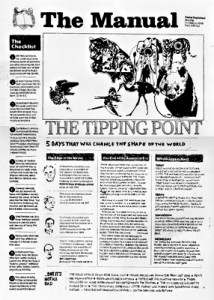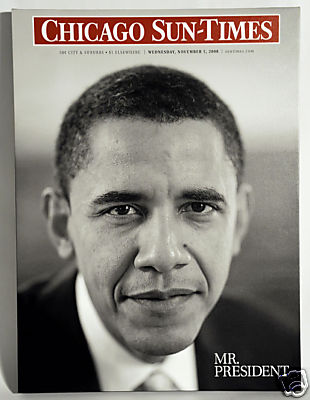We sorted through our 147 entries of 2008 to come up with the stories that surprised us, delighted us or made us shake our heads in disbelief. We’re presenting them as a series of posts entries over four days. Tomorrow we’ll conclude with our favorite quotes of the year.
Creative Solutions
A group of Ohio newspapers got together to share stories and even reporting assignments in a novel response to cost pressure. The Cleveland Plain Dealer, Columbus Dispatch, Toledo Blade, Cincinnati Enquirer and Akron Beacon Journal now post all their daily stories on a private website where editors can pick whatever they want and publish it in their own pages. The tactic has now been tested in several other parts of the US.
Pasadena Now, a small weekly, fired its entire editorial staff and farmed out coverage to a staff of Indian writers recruited on Craigslist. Publisher James McPherson pays the virtual staff about $7.50 per 1,000 words, compared to the $30,000 to $40,000 he was paying each reporter annually. The Indian writers “report” via telephones, web harvesting and webcams, with support and guidance from McPherson and his wife.
 Neighborsgo.com, a spinoff of the Dallas Morning News, uses a social network to anchor a community journalism initiative. Local residents create profiles and post information about their interests, and some celebrities are emerging, like the Helpless Housewife (right). Every week, editors dig through content submitted by citizens and produce 18 local print editions.
Neighborsgo.com, a spinoff of the Dallas Morning News, uses a social network to anchor a community journalism initiative. Local residents create profiles and post information about their interests, and some celebrities are emerging, like the Helpless Housewife (right). Every week, editors dig through content submitted by citizens and produce 18 local print editions.
Research and Markets released a report entitled “Offshoring By US Newspaper Publishers” that sees big growth in the newspaper outsourcing industry, particularly in India. About 2,300 people were employed offshore to serve US and UK newspaper companies in July, 2008, the report said. However, “The total offshore opportunity from newspaper publishers is estimated to be approximately $3.5 billion,” in the long run.
 A team of enterprising publishers in the UK produced a four-page newspaper created entirely by hand. “Every word and every image and every mark of any kind in The Manual was drawn by a team of volunteers – mostly illustrators,” the website says. The group foresees a day when “handmade qualities can transform newspapers from ‘junk’ to collectable.
A team of enterprising publishers in the UK produced a four-page newspaper created entirely by hand. “Every word and every image and every mark of any kind in The Manual was drawn by a team of volunteers – mostly illustrators,” the website says. The group foresees a day when “handmade qualities can transform newspapers from ‘junk’ to collectable.
The Politico, a Washington-based boutique news service that specializes in Capitol Hill coverage, signed up more than 100 newspapers for its news service, including the Arizona Republic, Des Moines Register, Atlanta Journal-Constitution and Philadelphia Inquirer. Launched in early 2007, the specialized print/online/broadcast hybrid focuses exclusively on politics, is reportedly profitable and has become a must-read for political junkies.
CNN announced plans to challenge the Associated Press with its own wire service. The AP suffered subscriber flight in 2008 as several large newspapers have canceled their subscriptions, claiming the price is too high.
 The Chicago Sun-Times offered 44 copies of its Nov. 5 front page on eBay as a “museum wrap fine art giclée print on canvas.” Nov. 5 was a rare bright spot in an otherwise disastrous year. The historic election created a brief surge of demand and many publishers sold out that day’s issue.
The Chicago Sun-Times offered 44 copies of its Nov. 5 front page on eBay as a “museum wrap fine art giclée print on canvas.” Nov. 5 was a rare bright spot in an otherwise disastrous year. The historic election created a brief surge of demand and many publishers sold out that day’s issue.
The Sun-Times had another idea to attract readers: It brought back dead columnists. “Vintage” columns written by Chicago institution Mike Royko began appearing in August, some 11 years after Royko died. The first one was about a Windy City citizen who was also dead.
Brave New World

Huffington Post employee Mayhill Fowler captured a three-minute rant by Bill Clinton about a Vanity Fair report that questioned the propriety of his post-presidential behavior. Fowler didn’t identify herself as a reporter but said she had the video camera in plain view while Clinton was talking. The LA Times account describes the recorder as “candy bar-sized” and Clinton claims to have not known he was being recorded.
CNN reported on a Yahoo employee who Twittered his layoff in February and gained an eager following. Ryan Kuder eventually took a job from the hundreds of leads contributed by his followers . His story was covered on prominent blogs and in mainstream media.
Talking Points Memo was awarded a George Polk Award for its coverage of the firing of eight United States attorneys. The New York Times account pointed to the difference between the new breed of online reporting and traditional print journalism. Chief among them is the involvement of readers in the process. Editor Joshua Micah Marshall has even been known to give “assignments” to his readers, asking them to comb through official documents.
Gutsy Moves
The Christian Science Monitor said it is all but exiting the print business. Management chose the paper’s 100th anniversary year to make the shift, attracting worldwide attention. The Monitor‘s dramatic move legitimized frequency cuts as a survival tactic. Other papers have followed its lead.
Editor & Publisher columnist Steve Outing cancelled his newspaper subscription and wrote about it at length, invoking a deluge of scorn from newspaper vets. Outing stuck to his guns.
Tampa Tribune intern Jessica DaSilva documented a contentious meeting about the need for change at the newspaper and posted the editor-in-chief’s comments on her blog. The young woman endured a torrent of abuse from veteran journalists, including many personal insults, as more than 200 comments piled up on her blog. The incident dramatized the industry’s difficulty in dealing with change.
Land of the Rising Seniors
Newspaper sales in Japan are 2.5 times those of the US as a percentage of the population and journalist layoffs are all but unheard of. The reason: the population is declining. The percentage of children 14 and younger is the lowest it’s been in 100 years and the overall population of Japan is expected to decline by a third over the next 50 years. The lack of a new generation of Web-savvy upstarts means papers have less pressure to move online and figure out how to serve a new audience.
Just Plain Fun
 The Onion offered a tutorial in how to write a provocative magazine cover line (right).
The Onion offered a tutorial in how to write a provocative magazine cover line (right).
A tongue-in-cheek investigation by IowaHawk rounded up recent incidents of criminal activity by journalists and concluded that newsrooms are at risk of becoming a “killing field.” Of course, the reporters could have conducted the exercise for lawyers, accountants or plumbers and come to the same conclusion. The best line was from Glenn Reynolds of Instapundit: “I think it’s unfair to single out journalists as thieves, or violent, or drunks, or child abusers. Sometimes they’re all of the above.” The chart is amusing, too.
 The Simpsons showed its snotty character Nelson insulting a journalist. “Hah hah! Your medium is dying!”
The Simpsons showed its snotty character Nelson insulting a journalist. “Hah hah! Your medium is dying!”
Comments
This entry was posted on Friday, January 2nd, 2009 at 10:00 am and is filed under Facebook, Fake News, Google, Hyper-local. You can follow any responses to this entry through the RSS 2.0 feed. Both comments and pings are currently closed.




[…] Death Watch has a nice list of change and innovation in news last year. It’s there; you just have to look for […]
[…] Best & Worst of 2008 – Gaffes Best & Worst of 2008 – Trends Best & Worst of 2008 – Changes […]
Hi, do you have a site in spanish language?
We want to recieve information about bulletins, or news about this site. Its very interesting .
Thank you.
[…] this is surprising, yet I’m not really as shocked as I should be. Pasadena Now, a small weekly, fired its entire […]
[…] Best & Worst Newspaper Innovations of 2008 […]